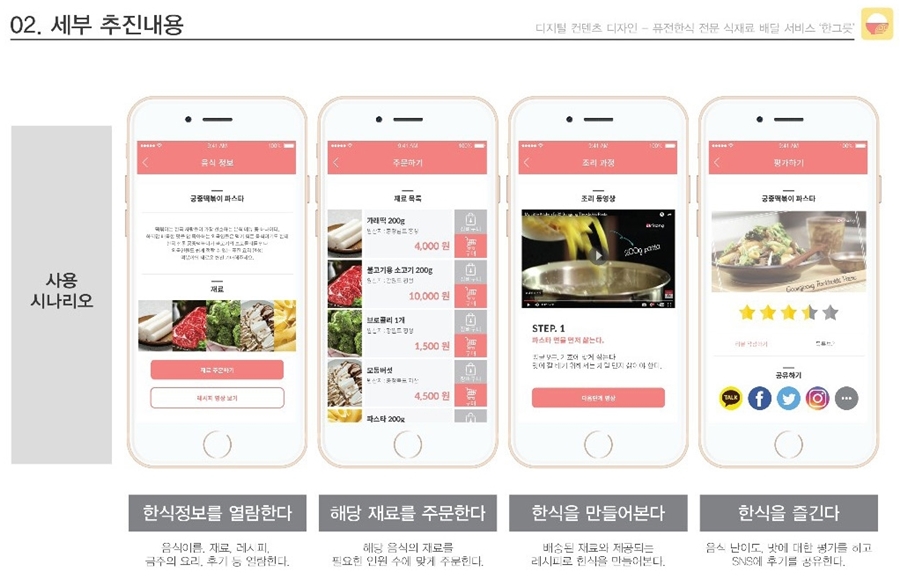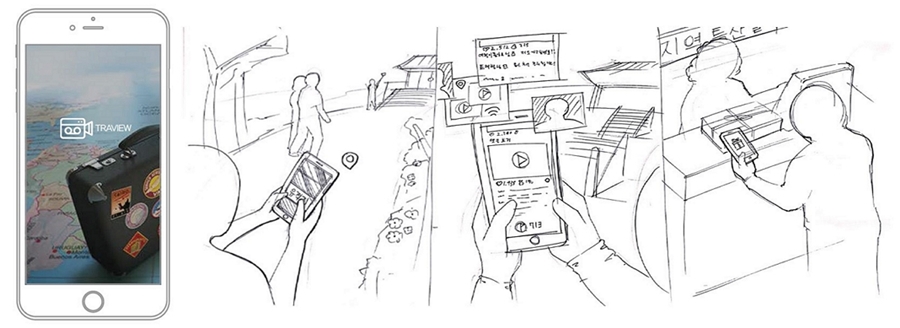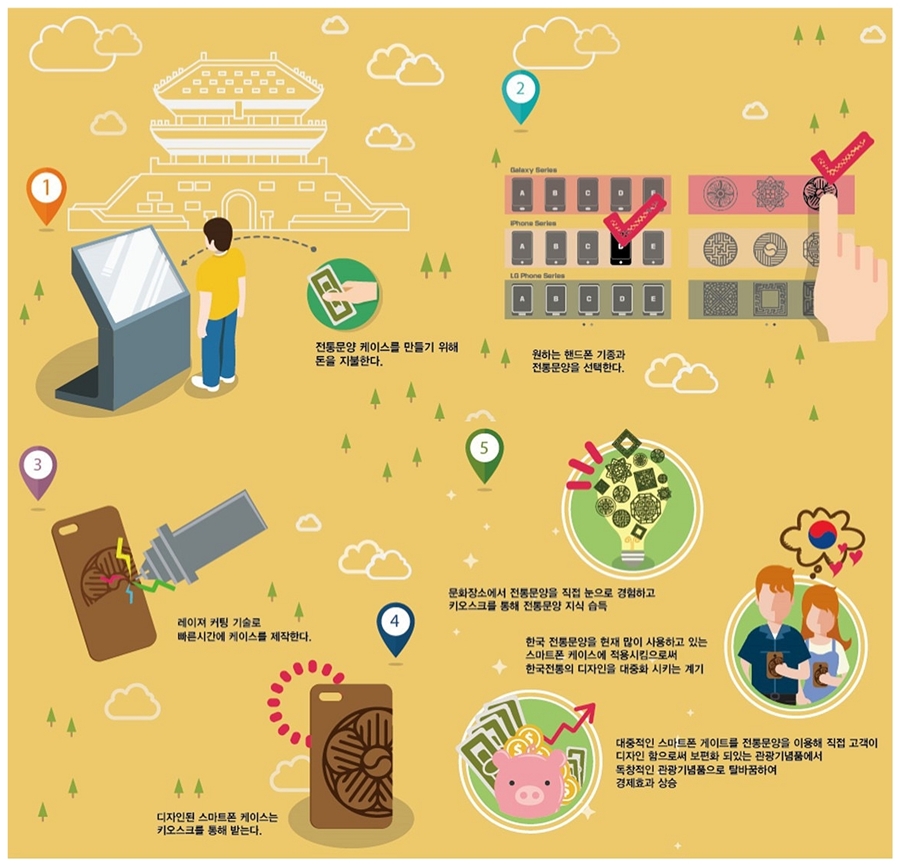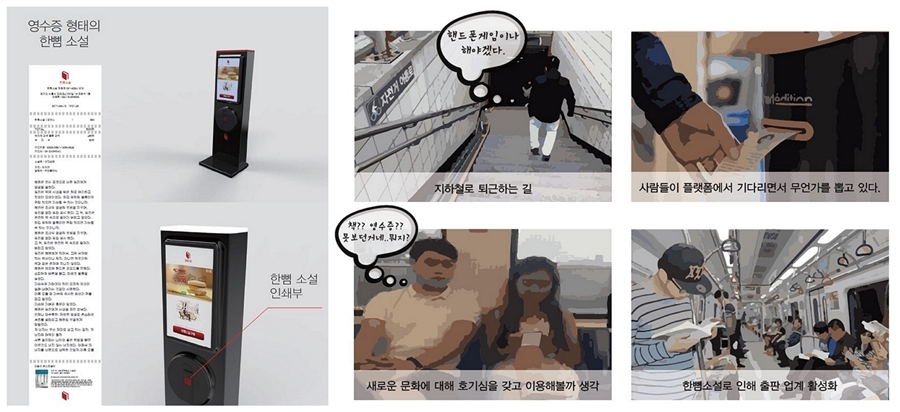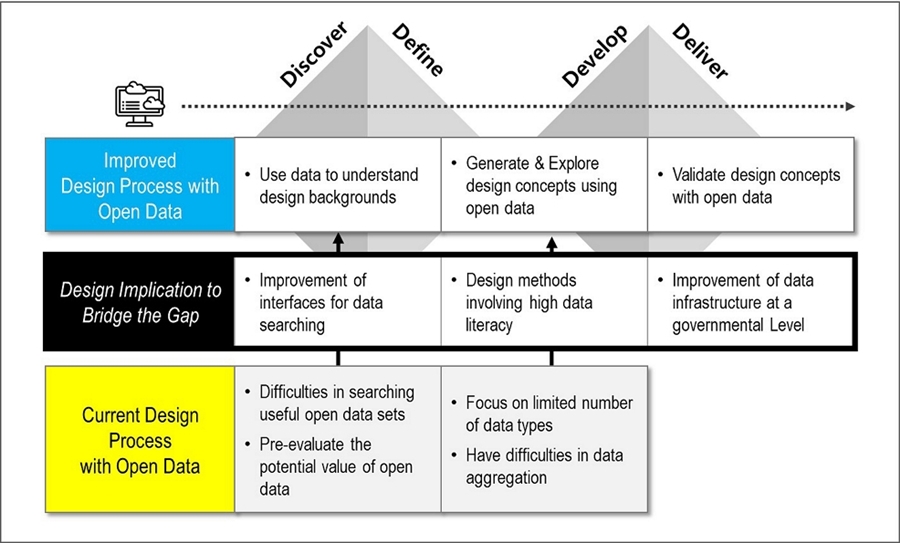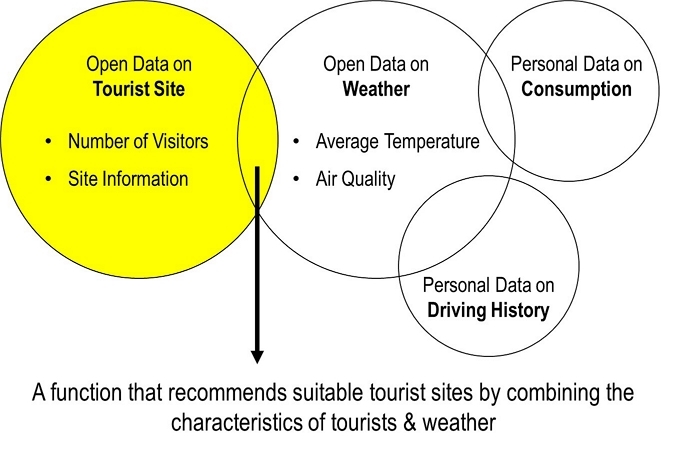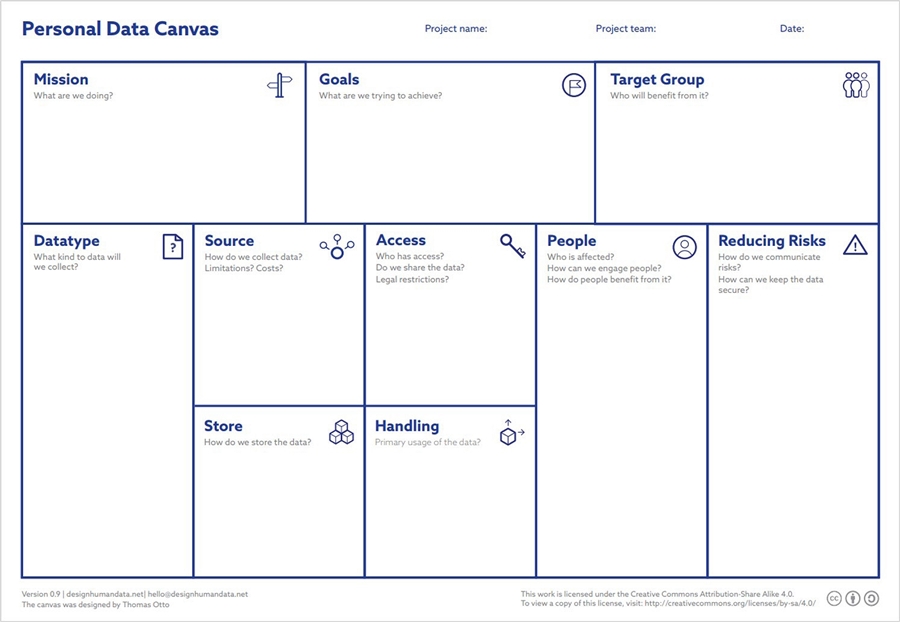
Challenges of Designing with Open Data: The Case of Cultural Data
Abstract
Background While the promise of a data-driven economy lies to a large extent in the development of new services and start-up companies, the results, in terms of products and services created, remain below open-data promoters’ expectations. Transforming the promise of a data-driven economy into a reality requires the exploration of difficulties in the field from a design-process perspective.
Methods We conducted a design workshop and analyzed how general designers used open data in the design process. The study lasted four weeks in which participant groups worked on the four phases of the design process. Over the first two weeks, we asked participants to scan the open data sets. Then, considering usable open data, as well as possible target users and their problems, the groups of participants defined their design spaces. The participant groups were asked to concretize design concepts that utilized open data and deliver final outcomes after another two weeks.
Results In our study, we found that participants used open data as a new material. However, their data use was limited to listing existing data or simply editing data without imposing deep and diverse modifications. Furthermore, they tended to consider the immediate availability of the most important factor and therefore preferred open data that they deemed easy to use on the basis of existing design cases.
Conclusions Our findings yielded several practical design implications, such as the urgent need for improved data-searching interfaces, design methods with high data literacy, and enhanced data infrastructure at the governmental level. The study’s results and design implications will hopefully inspire other designers and researchers to develop open data ecosystems that are more designer-friendly.
Keywords:
Open Data, Service Design, Interaction Design, Design Process1. Introduction
Open data is defined as data that anyone can freely access, use, modify, and share for any purpose. Worldwide, public sector organizations are implementing open-data initiatives, which will hopefully stimulate economic growth, increase transparency and accountability, and improve engagement between data consumers (typically citizens) and data holders/publishers (Open Knowledge International, 2018).
Over the past few years, economic policies have reflected the dominant orientation toward the establishment of a data-driven economy, based on the wider availability of data, promoted especially by proponents of the open-data movement (Chui, Diana, & Steve Van, 2013) and the development of dedicated tools to support heterogeneous data and data in large quantities (Foulonneau, Turki, Vidou, & Martin, 2014).
While the promise of a data-driven economy lies, to a large extent, in the development of new services and start-up companies (Hammell, Perricos, Branch, & Lewis, 2011), the results, in terms of products, services, and start-ups created, remain below open-data promoters’expectations of open-data. Indeed, most of the services created focus on similar areas and rely on a limited number of very popular data sets.
From the perspective of design, one challenge that might arise comes from the difficulty of utilizing open data when designing new products or services (Boehner & DiSalvo, 2016; Elsden et al., 2016; Feinberg, 2017). While various studies have already researched how information data systems can lead to citizen engagement (Lee, 2018), research on designs for open data is still lacking. In order to make the promise of a data-driven economy a reality, it is therefore necessary to (i) “explore the difficulties involved in the design process and (ii) investigate how to support a design process using an open data set.
2. Related Work
The Double Diamond is a general visual map of the design process that is divided into four distinct phases – discover, define, develop, and deliver (Design Council, n.d.).
- • Discover phase – The first quarter of the Double Diamond model covers the start of the project. Designers try to look at the world in a fresh way, notice new things, and gather insight.
- • Define phase – The second quarter represents the definition stage, in which designers try to make sense of all the possibilities identified in the discover phase. What matters the most? What should we act on first? What is feasible? The goal here is to develop a clear, creative brief that frames the fundamental design challenge.
- • Develop phase – The third quarter marks a period of development in which solutions or concepts are created, prototyped, tested, and iterated. This trial-and-error process helps designers improve and refine their ideas.
- • Delivery phase – In the delivery stage, the final quarter of the Double Diamond model, the resulting project (e.g., a product, service, or environment) is finalized, produced, and launched.
In our study, we analyze the use and problems of using open data based on this design process model. In the following section, we describe previous research conducted on the use of open data at each stage.
2. 1. Utilization of Open Data in the Design Process
Researchers have relied on data to understand users. In particular, they have used open data to understand the context of the target user. For instance, the Data Material Book explains the use of government data sets (data sets from different ministries from sectors such as state budget, traffic, or environment) during the discover and define phases (Otto, 2018). However, while the open data provides useful information, in a relatively inexpensive way, it reflects the difficulty of locating specific information among a large amount of data sets.
Among the studies in the HCI (human computer interaction) field, there are cases where the target user is defined through utilization of data. Of course, this is not an instance of open data, but it does exemplify the mode by which designers come to understand the problem situation and users with large amounts of data. For example, Zhang et al. presented a quantitative bottom-up data-driven approach to create objective personas (Zhang, Brown, & Shankar, 2016). They assembled user behavior via clicks gathered automatically from telemetry data related to actual product use in the field. They then aggregated 3.5 million clicks from 2400 users into 39, 000 clickstreams. Then, using a statistical approach, the data were used to generate five representative personas. According to the study, the five generated personas were validated by user behavior experts (via interviews), who verified that these personas did, in fact, represent archetypal users of our product.
During the develop phase, design concepts are created through a process of idea generation. While there are various design methodologies used for concept generation, a methodology that relies on the utilization of open data for concept generation is rare. Notwithstanding research on data visualization, not many studies provide guidance on how to generate a design concept that uses open data as a core component of a product or service.
Although the Design Human Data Kit is not designed for open data use alone, it furnishes useful tools for the systematic analysis of data and design concept generation (Otto, 2018). The Design Human Data Kit is a set of tools and information that enables designers and their interdisciplinary teams to create sustainable and user-centered data services. This includes basic personal data, as well as tools for the design process, to facilitate discussions on the creation of data services. In particular, the kit includes the following design tools: Personal Data Cards, Privacy Model, and Data Canvas.
- • Personal Data Cards is a compilation of cards to analyze and discuss aspects of people, ethics, and data service security. This compilation of cards covers different aspects besides these requirements and places the focus on humans in form of personal data sources, security measures and ethical aspects.
- • Data Canvas is a framework to examine the developed ideas from different perspectives. Similar to business model canvas, Data Canvas can be used as a template for developing new service models or documenting existing ones, on the basis of data sets.
- • Privacy Model helps to assess the sensitivity of people’s personal data. This model shows the different types and levels of personal data from humans considering transparency, value and control.
The kit can help designers attain experience in and develop attitudes toward the use of personal data, including ethical issues. The Personal Data Cards will be especially useful at helping designers understand the source of certain data and how to store and handle such data in the context of their design concepts. Further, the Personal Data Canvas and Privacy Model may help designers to validate their design ideas from various perspectives.
Finally, open data may be also used in the deliver phase of design. Indeed, for concept validation, open data sets can only be used to test a service concept. For example, recommendation systems are often tested against standard data sets, such as MovieLens (http://grouplens.org/datasets/movielens/) which has gathered user ratings across many movies. Designers and developers can then test their new algorithms against the data set to verify predictive accuracy regarding user ratings and evaluate its performance, relative to the performance of numerous other algorithms. Likewise, the use of open data may not be reflected by the final service. However, the data are acknowledged to play a critical role in enhancing the quality of the service and ensuring its viability.
2. 2. Summary
Given the use of open data across all design phases, designers and researchers have obviously recognized the potential of open data to provide valuable insights into user behavior in a design process. They also have tried to render open data an important component of a given product or service, with which an end user may interact to gain actionable insights (Wolff, Seffah, Kortuem, & van der Linden, 2018). However, there is a lack of methodological scholarship concerning the practical use of open data as a major component of a product or service.
3. Method
3. 1. Goal of Study
Despite previous research conducted on the use of open data in the design process, we have limited knowledge to determine how a given designer will interpret open data and apply it to the design process. We are conducting this study to confirm that systematic design strategies or methods are needed to maximize the potential value of open data. We also attempt to explain how to effectively apply open data to a design process.
Like previous studies, which were conducted in exploratory settings (Rosner, Kawas, Li, Tilly, & Sung, 2016), we administered a design workshop, in which we provided participants with open data on culture and directed participants to generate a design concept, in accordance with the standard design process.
Our study aimed at understanding how open data impacts the general design process rather than suggesting innovative design cases. Several research questions were thereby developed:
- • How do designers use open data, generally, in the design process and, specifically, in the respective discover, define, develop, and deliver phases?
- • What kind of open data is heavily used and why? Are there a kind of consensus in terms of data being heavily used, as in used by the most designers?
- • How are open data processed and applied when designers deploy such open data to function as an important component of a product or service?
- • How can designers capitalize on open data more effectively?
3. 1. Study Setup
We conducted a design workshop with 40 design-major students (age = 23.2, SD = 2.2). Fourteen groups, each composed of two to three students, were organized during a workshop. On average, participants had studied industrial design and UX design for 3.4 years. Of the 40 participants, 13 respondents asserted knowledge of the concept of open data. However, none of the 40 respondents claimed to have conducted a design project using open data. These participants were suitable for our study, due to their experience designing various services, products, and mobile applications and knowledge of the general design process. Throughout the design workshop, we were able to ask the participants to compare the general design process with the design process that uses open data. We also analyzed their use of open data during the design process.
In the first week of the design workshop, we briefly introduced the concept of open data and showed participants the website where they could find open data.
For the purposes of our research, we narrowed our focus to the use of open data in the context of various cultural areas. Open data on culture was suitable for use in our experiments, because it included geographical data, textual data, images, and so forth. Such attributes render cultural open data similar to general open data, except for its restriction to culture-related topics. In particular, because we provided the data sets through one data portal (http://www.culture.go.kr/data/), participants easily searched and explored the data sets during the experiment.
The cultural data portal provides open data on art and culture, cultural heritage, cultural industry, tourism, sports, books, policy support, and cultural promotion. This site provides information on the organizations active in each field and introduces open data sets provided by such organizations provide. Users can search and retrieve various cultural data, including items on local festivals, cultural assets, performances, exhibitions, books, sports facilities, copyright, cultural-content industry, and the Korean language through each institutions API and website.
Although, in our study, we asked participants to principally use cultural data, we encouraged them to seek out other open data sets and incorporate data from those as well.
3. 2. Study Process
The study lasted 4 weeks and explored four phases of the design process. In the first 2 weeks, we asked the participants to proceed through the discover and define phases. Specifically, we directed them to scan the open data sets available on the data portal site. Then, after consideration of the usable open data and possible target users and their problems, groups of participants defined their design spaces.
We asked them to proceed through the develop and deliver phases over the next 2 weeks. The participants were asked to concretize their design concepts that used open data or to use open data to concretize their design concepts and deliver final outcomes. The final outcomes consisted of the participant groups’ completed design cases, comprised of descriptions of their service concepts, user scenarios, and key scenes in the service applications.
After each 2-week period, we interviewed the group of participants. The goals of the interview were twofold: 1) to investigate what kinds of open data they were using to generate their designs and why they were using them and 2) to get feedback about the design process (relative to the general design process).
To analyze the participants’ experiences with open-data usage, we took an inductive-qualitative analytical approach to the interview data. We made audio recordings of and transcribed all of the interviews (comprising a total of 7 hours). Then, we employed a method of qualitative analysis to iteratively develop a classification scheme. In the early stage of the analysis, we classified the study’s results, in accordance with the general design process (proceeding through discovery phase, define phase, develop phase, and deliver phase). After this step, we reassembled the findings to gain meaningful insight from each phase.
4. Results
4. 1. Distinctive Nature of Design Process
How do designers use open data in the overall design process and in the discover, define, develop, and deliver phases, respectively? During the interview process, we identified the distinctive nature of the design process using open data. Most participants described the process as challenging, because it differed from a typical design process. In a general process, designers tended to utilize data to understand users, identify problems, understand trends in discovery, and define phases. In our study, we found that a design process using open data focused primarily on determining the value of the data itself, in advance, rather than understanding target groups or suggesting new ideas. All participant groups said that they began by exploring the data portal at first and prejudging the kinds of products or services most suited to using the open data: “I used to look at the data at the National Statistical Office to understand user trends. However, in this experiment, I was most concerned about utilizing the data itself rather than understanding the user” (P11, designer of Road Friend).
After their preliminary explorations of the open data sets, they chose target user groups and design contexts. The data was then used as design material, constituting the main functions and features of the proposed products or services. In this phase, they explored additional details of the open data, such as its type, specific content, and so forth.
In this study, a total of 14 design cases were derived from this study (Table 1). These cases were mainly based on cultural data and were designed in the form of mobile applications, services, and products. In the below paragraphs, we will explain what kinds of open data were used and how they were utilized in the designs.
4. 2. Type of Open Data Used
What kind of open data is heavily used and why? In the design cases, we identified tourism (6 times) and cultural heritage (5 times) as the most popularly used among various open-data types (Table 2). These data were mainly used in mobile applications, to provide users with information about attractions and historical sites. For example, Road Friend, Great Mom, and Bicycle Rental used open data on culture heritage, cultural industry, and tourism.
When we inquired about the reasons behind their decisions to use this data, participants said that it was the easiest to understand and had many existing use cases: "When I explored the data portal, I read data about tourism which contained a list of attraction sites or good restaurants. Because it was well organized, I thought that I could provide the data about tourist sites through a mobile application" (P15, designer of Great Mom).
When we looked at the types and frequency of data used, we did not identify a clear correlation between the number of times a given type of data was used in design cases and the number of data providers and open APIs (“Cultural Data Casebook,” 2017). Rather, we observed that certain categories of data, such as tourism, were more popular among a variety of designs, even if only one agency provided the open data set.
4. 3. Type of Open Data Utilization
How are open data processed and applied when designers treat such data as an important component of a product or service? We categorized the design cases according to the ways the data were used. We analyzed the modes of applying the data to the cases. Throughout our study, we categorized the design cases into four types (Table 3): Open Data Filter for Target Group, Open Data-based User Participation Platform, Open Data as Aesthetic Material, and Copyright-free Open Data Provider. Some ideas belonged to multiple categories at one time.
The most popular type of outcome designed by participants was a mobile application or website that helped consumers search for culture-related information. Because of the overwhelming magnitude of available open data, these cases were designed to provide filtered data, tailored to a target audience, on cultural events, attractions, or historical sites.
For instance, Great Mom, a mobile application for mothers with infant children, allows users to browse places or events they may want to visit; it operates by filtering information on the basis of their region, as well as their children's tastes and ages. Another case is Road Friend, which provides information on cultural experience programs, by region, and enables users to book them. The One Bowl application introduces Korean food recipes and allows users to order ingredients (Figure 1). Unlike the two previous cases, this application also utilized multimedia data, such as photographs and images.
Another type of design case was a platform, based on open data, which supported interactions between users within the platform
For example, Party Together is a web-based platform that links users who want to host an event with companies that help prepare and administer such events. This service uses open data to register the schedules of nationwide events and related business listings. The platform generates revenue by mediating user-company encounters: “Open data was essential to devise our idea. It will be possible to create a foundation of our service platform with open data and use it to drive users to our services when there is insufficient data on our platform in the early stages of service” (P39, designer of Party Together). Similar to open-data filter applications, the Traview application, which recommends tourist attractions (Figure 2), is also a platform where users can upload realistic video reviews and generate a user community. To encourage more participation, users receive bonus points, which can be used during travel.
We found that designers tried to build their services on a foundation of open data, which is free to the public and represents an extensive amount of information
Among the cultural data sets, some could be utilized as aesthetic material. Open data on traditional patterns, in particular, were used twice among the design cases. For instance, Postcard Printer is a kiosk at cultural heritage sites or sightseeing spots that helps visitors craft unique postcards. Visitors can design postcards by combining traditional patterns and sightseeing photos through the kiosk interface. Similarly, My Phone Case is a kiosk that engraves traditional patterns on smartphone covers (Figure 3). Using the kiosk, users can generate custom designs and engrave them on smartphone covers. The participants noted that they wished to generate visually aesthetic graphics by editing the open data sets to adapt the traditional beauty of the patterns to a more modern style sensibility.
In addition, data in the form of photographs of historical remains and artifacts were also frequently used. Play Pamphlet used image data on cultural sites or artifacts to make visually appealing pamphlets. By printing images on foldable structures, users can assemble the pamphlets into souvenirs: “We gathered free image data of the ruins in the data portal. Then, we tried to create additional value by editing them” (P9, designer of Play Pamphlet).
Similar to the cases above, several open data sets, in the form of images, were used to produce objects that people could physically own without employing designers’ complex data alterations and aggregations.
In the case of cultural data, some open data consisted of novels, poetry, and paintings, which represents data of substantial economic and cultural value. In particular, some data sets lacked legal copyrights, thereby rendering them available for use by anyone. Some participants utilized this data to create a design type that enabled the public to easily access copyright-free data sets.
Hand-span Novel is a service that requests payment from passengers of public transportation to read a portion of an article or novel (Figure 4). The participants who designed this service explained that they had discovered a considerable amount of copyright-free literature from which they could profit.
This type of design case identified and distributed open data of intrinsically high economic value. The designers thereby constructed a service channel to facilitate the distribution of valuable open data in a way that avoids the cumbersome processes of data searching, packaging, and transformation.
5. Discussion
In our experiment, we explored how designers use open data. Participants tried to find usable types of open data sets and judged the potential value of the open data early on, during the discover and define phases (Figure 5).
During the develop phase, participants mainly limited their use to only one or two types of open data. The fact that the participants relied most heavily on tourism data (information about attractions and historical sites) indicates a tendency to regard instant availability as the most important factor; they thus demonstrated a preference for open data that seemed easy to use, based on existing design cases
Our study allowed us to confirm that open data were utilized in mainly four ways: Open Data Filter for Target Group, Open Data-based User Participation Platform, Open Data as Aesthetic Material, and Copyright-free Open Data Provider. As described in the results of our study, participants used open data as a new material; however, their data use was limited to listing existing data or simply editing data without imposing deep and various modifications.
The question remains: How can designers make better use of open data? To fully exploit specific material, participants require knowledge on the properties of the materials and the methods for utilizing them in various ways. In the following section, we discuss potential design implications in the design process and how to support designers’ creative uses of open data.
5. 1. Discover and Define Phase: Improvement of Interfaces for Data Searching
If a product designer makes a new lamp, he/she will experiment with different types of material to identify one that may be suitable for the lamp shade or various bulbs, capable of emitting various colors. However, as the experiment shows, the participant groups tended to rely on one or two data sets, as opposed to seeking out additional open data sets. They selected a limited number of open data sets, in advance, for use as their main design material, and tried to accommodate target users and situations appropriate for that data. This may be attributed mainly to the fact that it was difficult for designers to search for and retrieve the open data they needed in the current data portal.
To encourage designers to explore more diverse data, it may be necessary to develop a data-portal interface that supports designers' work practices. In the current data portal, data are classified as Arts & Culture, Cultural Heritage, Cultural Industry, Tourism, Sports, Books, Policy Support, and Cultural Promotion. Superficially, the data seems to be divided according to the subject, but the data portal first categorizes institutions by subject, after which it presents the data that belongs to these categorized institutions. In other words, to obtain data on tourism, designers must have knowledge of the category to which the Korea Tourism Organization belongs to.
Rather than showing open data by institution, it would be more useful to arrange the data according to a designer’s real practice of data use. For instance, if the portal provided open data by subject, that is, showed similar data sets within the same subject, the user would be able to find and explore more diverse data from different institutions. For example, if a user enters the keyword “weather,” the portal should yield relevant information, such as data concerning fine dust, temperature, and festivals. Another alternative would be to search by data type (e.g., text, image, xml, json), in combination with data provider.
Thus, future research should investigate investigation of the attributes that designers use to evaluate the value of open data or the features of open data that designers actually use to create new design concepts. Doing this may render the development of a data portal, operable in a findable and usable manner from viewpoint of the designer (i.e., main user), a real possibility.
5. 2. Develop Phase: Needs of Design Methods Involving High Data Literacy
Data science can be understood in terms of seven stages: acquire, parse, filter, mine, represent, refine, and interact (Fry, 2004). In other words, data requires many processes, including aggregation, to be meaningful. Tracking the number of steps that people take in a day is worthless, unless they compare that number to a reference standard, and tracking the steps taken in a single day yields little information about overall activity or fitness. While digital environments increase the potential scale of aggregation tremendously, our experiments show that designers have difficulty performing data aggregation (such as transforming or combining open data sets). As shown in the design cases, our participants tended to focus on the types of open data that seemed immediately applicable. In other words, their lack of knowledge on how to utilize open data in various ways mandated their regard of the instant availability of the data itself as the most important factor.
In particular, design types Open Data as Aesthetic Material and Copyright-free Open Data Provider demonstrated that designers tended to focus on instant availability. These two design types relied on aesthetically and economically valuable data sets. The former utilized data on image types with high visual value. For example, designers directly applied images of traditional patterns or artifacts provided through the data portal. The second type used text-type data with a high literacy value. However, one of the biggest challenges associated with those types is the limited amount of high-quality data. These types of cases may be successful or forced to terminate, depending on whether government agencies continue to discover and provide new data to fuel the designs. Thus, designers need to investigate novel ways to create additional value through data aggregation.
The Open Data Filter for Target Group was the most common design type in our study. Participants designed mobile/web applications that provided users with open data on restaurants and tourist sites. However, relative to existing applications on the market that use the same data source, the competitiveness of the design cases is not high.
Moreover, effectively designing the provision of open data is not just a matter of attractive presentation. It is to list more than one kind of data sequentially. Like prior research projects, designers must be able to assemble insights from among vast quantities of open data to build services that help users browse for data as they prefer (J. Kim et al., 2015; N. W. Kim et al., 2016). Another possible method involves deriving a new meaning from alternative ways of combining additional data. For example, recommending a tourist route that accounts for the weather, by including weather data, would be more helpful to users than simply presenting tourist information, a feature many other platforms have.
As described above, despite the open data’s vast potential, designers who were unfamiliar with data use tended to lack understanding on how to utilize open data. In our experiment, no participant group performed any high-level analysis of open data provided by an institution, and they rarely synthesized various types of open data to generate additional value from the data they were using. This may be due to the fact that, in general, designers rarely understand the nature of open data and how to use it in design process.
According to the work conducted by Feinberg (Feinberg, 2017), designers should be able to understand the context of open data-how it was collected and for what ends-and the utilization techniques of data. One possible way to improve designers’ data literacy would be to focus on design methods. The role of design methods is to support design work, the aims of which can vary. Such aims may include gaining key insights or unique essential truths that result in more holistic solutions, thereby achieving better experiences for users, through products, services, environments, and the systems on which they rely.
One possible method is to adopt the design of Data Mixer, which was devised to support the combination of diverse open data (Figure 6). It can help designers identify associations and values among different types of open data that designers may previously have regarded as irrelevant. For instance, rather than just listing data on a tourist site, designers may be able to combine open data on weather and on the number of visitors to a tourist site with additional personal data on individuals’ consumption or driving history. If there is a design method that helps designers anticipate the outcome of combining data sets, they may be able to create a service that recommends tour routes suitable under diverse conditions.
Another possible method is to learn from the Data Recipe Book, a collection of recipes describing various ways of utilizing the most popular open data. The current data portal already shows good examples that utilize open data. However, it lacks sufficient descriptions on the types of open data being used and how that data is applied to a given design case. In a format similar to that of a Personal Data Canvas (Otto, 2018) (Figure 7), designers may be able to share information on collecting, transforming, and storing open data. Then, designers will be able to learn from data recipes that provide various examples of how designers and data scientists can filter, analyze, and combine open data.
5. 3. Deliver Phase: Improvement of Data Infrastructure at a Governmental Level
The deliver phase is the stage in which the resulting project is finalized, produced, and launched. In our experiment, the final outcomes were limited to the conceptual level, which did not pose a substantive problem, but participants suggested that the open data base should be consolidated, at the government level, to ensure the maintenance of new services based on the open data. In other words, because creating, formatting, and managing open data requires resources, the mode of supplying the open data should, at least, be considered in the delivery phase.
Feinberg’s (2017) study showed that some cities do not open a data stream to the public until there are enough project proposals to use that data. Even where there is sufficient demand to drive the opening of a data source, issues regarding the fidelity and frequency of data must be considered (McMillan, Engstrom, Lampinen, & Brown, 2016).
Some data sources are collected or updated manually and, while this process can fulfil the government’s purpose in collecting this data, it may not lend itself to sufficient frequency to be useful for third-party designers and developers. In sum, data can be collected in a way that suits a specific purpose but renders it unusable for other projects.
Thus, to provide valuable open data, long-term and in a usable form, continuous interaction with potential users (e.g., citizens, designers, developers, entrepreneurs) is essential, because users may have disparate demands concerning that data. For instance, regularly holding design workshops for users and government officers may facilitate a dialogue that explores innovative design ideas using open data and discusses how to improve open data policies that support these ideas.
5. 4. Limitations
This research is valuable as an early-stage study to confirm that systematic design strategies of open data usage are required. However, there are limitations.
First, the open data in this study cannot be generalized to all open data because, in this study, the data focused mainly on culture and therefore has different characteristics from other government-provided data. For instance, copious open data on culture comes in the form of images (e.g., artifact photographs, traditional patterns) or literary works (e.g., novels, work images). Given this, different design types may apply to open data on topics that rely on other formats.
Another limitation is that the participants were not professional designers. Although this paper provides a preliminary understanding of how people who are accustomed to products, service design, and so forth, understand and use data, future research must analyze the results of actual use by professional designers or start-ups. Additionally, it is necessary to endorse a design method that encourages usage of open data comprising the core parts of services or products and study whether the design method can help designers generate innovative concepts.
The final limitation is related to the distinctions in information infrastructure that characterize each country. Korea is known to be fairly advanced, in terms of information disclosure. Because policy support varies by country, the challenges facing designers may vary across countries with different economic situations.
6. Conclusion
To make the promise of a data-driven economy a reality, it is crucial to explore difficulties from the perspective of the design process. By conducting a design workshop with open data, we discovered the distinctive nature of the design process using open data. A design process using open data focuses primarily on finding the value of data itself, in advance, rather than on understanding target groups or suggesting new ideas. Open data was utilized in four types of design cases: Open Data Filter for Target Group, Open Data-based User Participation Platform, Open Data as Aesthetic Material, and Copyright-free Open Data Provider. Participants used open data as a new material; however, their data use was limited to listing existing data or simply editing data, without imposing deep and various modifications. Also, they tended to consider the instant availability of data as the most important factor, and thus preferred open data that seemed easy to use, based on existing design cases. Our findings yielded several practical design implications, such as the need for improved interfaces for data searching, for design methods involving high data literacy, and improvement of data infrastructure at a governmental level. Hopefully, the study’s results and design implications will inspire other designers and researchers to develop more designer-friendly open data ecosystems.
Acknowledgments
This work was supported by the National Research Foundation of Korea Grant funded by the Korean Government (NRF-2017R1C1B5018268).
Notes
Copyright : This is an Open Access article distributed under the terms of the Creative Commons Attribution Non-Commercial License (http://creativecommons.org/licenses/by-nc/3.0/), which permits unrestricted educational and non-commercial use, provided the original work is properly cited.
References
-
Boehner, K., & DiSalvo, C. (2016, May). Data, design and civics: An exploratory study of civic tech. In Proceedings of the 2016 CHI Conference on Human Factors in Computing Systems (pp. 2970-2981). ACM.
[https://doi.org/10.1145/2858036.2858326]

- Chui, M., Diana, F., & Steve Van, K. (2013). Generating Economic Value through Open Data. In Brett Goldstein (Ed.), Beyond Transparency (pp. 151-161). Cambridge University Press.
- Cultural Data Casebook. (2017). Korea Culture Information Service Agency.
- Design Council. (n.d.). Double Diamond Model. Retrieved February 13, 2019, from https://www.designcouncil.org.uk/news-opinion/design-process-what-double-diamond.
-
Elsden, C., Nissen, B., Garbett, A., Chatting, D., Kirk, D., & Vines, J. (2016, May). Metadating: exploring the romance and future of personal data. In Proceedings of the 2016 CHI Conference on Human Factors in Computing Systems (pp. 685-698). ACM.
[https://doi.org/10.1145/2858036.2858173]

-
Feinberg, M. (2017, May). A design perspective on data. In Proceedings of the 2017 CHI Conference on Human Factors in Computing Systems (pp. 2952-2963). ACM.
[https://doi.org/10.1145/3025453.3025837]

- Foulonneau, M., Turki, S., Vidou, G., & Martin, S. (2014). Open data in Service design. Electronic Journal of E-Government, 12(2), 99-107.
- Fry, B. J. (2004). Computational Information Design. SciencesNew York.
- Hammell, R., Perricos, C., Branch, D., & Lewis, H. (2011). Unlocking growth: How open data creates new opportunities for the UK. Growth (Lakeland). London, UK.
-
Kim, J., Ko, E. Y., Jung, J., Lee, C. W., Kim, N. W., & Kim, J. (2015, April). Factful: Engaging taxpayers in the public discussion of a government budget. In Proceedings of the 33rd Annual ACM Conference on Human Factors in Computing Systems (pp. 2843-2852). ACM.
[https://doi.org/10.1145/2702123.2702352]

-
Kim, N. W., Jung, J., Ko, E. Y., Han, S., Lee, C. W., Kim, J., & Kim, J. (2016, February). Budgetmap: Engaging taxpayers in the issue-driven classification of a government budget. In Proceedings of the 19th ACM Conference on Computer-Supported Cooperative Work & Social Computing (pp. 1028-1039). ACM.
[https://doi.org/10.1145/2818048.2820004]

-
Lee, M. H. (2018). A Study on Citizens' Public Report Application Usage. Archives of Design Research, 31(3), 49-66.
[https://doi.org/10.15187/adr.2018.08.31.3.49]

-
McMillan, D., Engström, A., Lampinen, A., & Brown, B. (2016, May). Data and the City. In Proceedings of the 2016 CHI Conference on Human Factors in Computing Systems (pp. 2933-2944). ACM. New York, New York, USA: ACM Press.
[https://doi.org/10.1145/2858036.2858434]

- Open Knowledge International. (2018). OPEN DATA HANDBOOK. Retrieved August 20, 2008, from http://opendatahandbook.org/.
- Otto, T. (2018). Design Human Data Kit. Retrieved February 11, 2019, from https://designhumandata.net/.
-
Rosner, D. K., Kawas, S., Li, W., Tilly, N., & Sung, Y. C. (2016, February). Out of time, out of place: Reflections on design workshops as a research method. In Proceedings of the 19th ACM Conference on Computer-Supported Cooperative Work & Social Computing (pp. 1131-1141). ACM.
[https://doi.org/10.1145/2818048.2820021]

-
Wolff, A., Seffah, A., Kortuem, G., & van der Linden, J. (2018, May). Designing for Effective Interactions with Data in the Internet of Things. In Proceedings of the 2018 ACM Conference Companion Publication on Designing Interactive Systems (pp. 415-418). ACM.
[https://doi.org/10.1145/3197391.3197402]

-
Zhang, X., Brown, H. F., & Shankar, A. (2016, May). Data-driven personas: Constructing archetypal users with clickstreams and user telemetry. In Proceedings of the 2016 CHI conference on human factors in computing systems (pp. 5350-5359). ACM.
[https://doi.org/10.1145/2858036.2858523]


